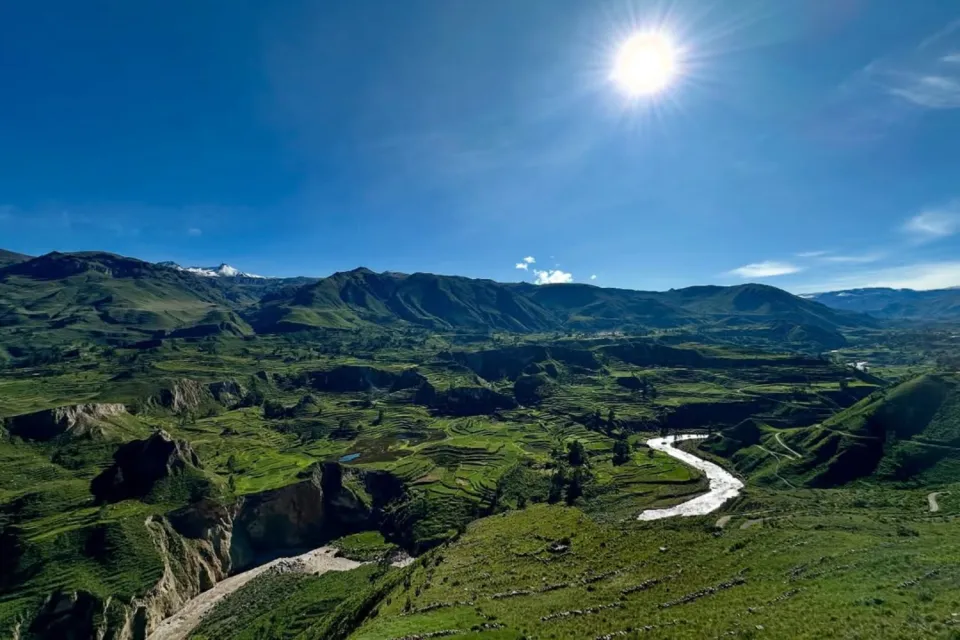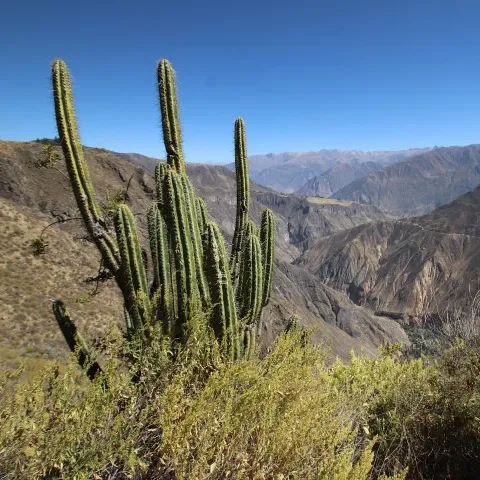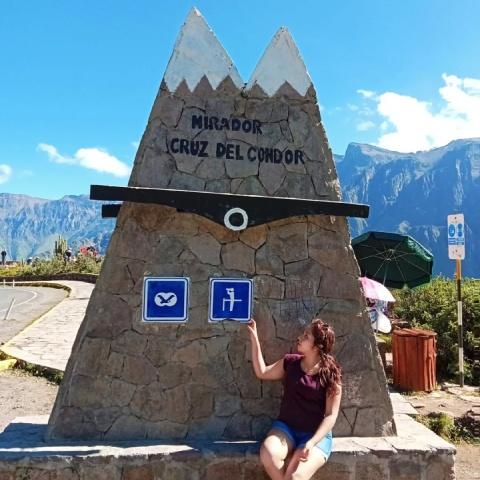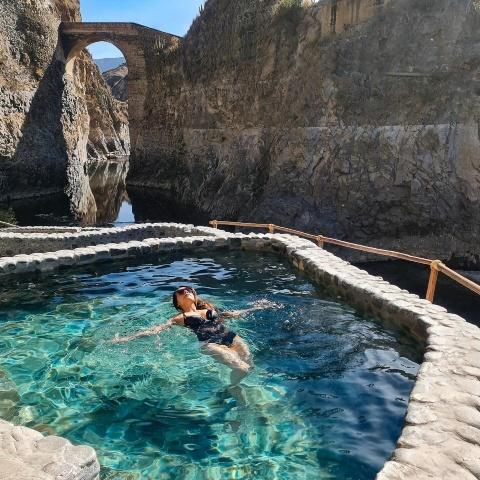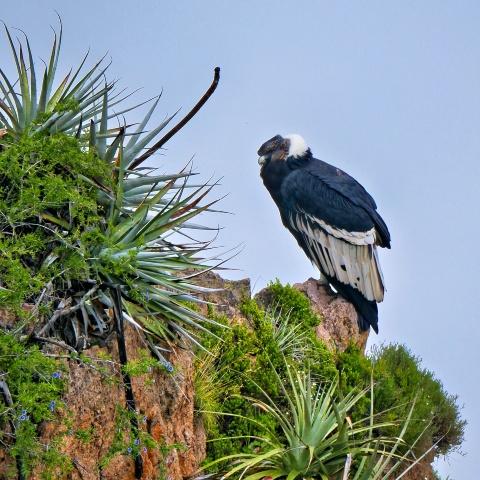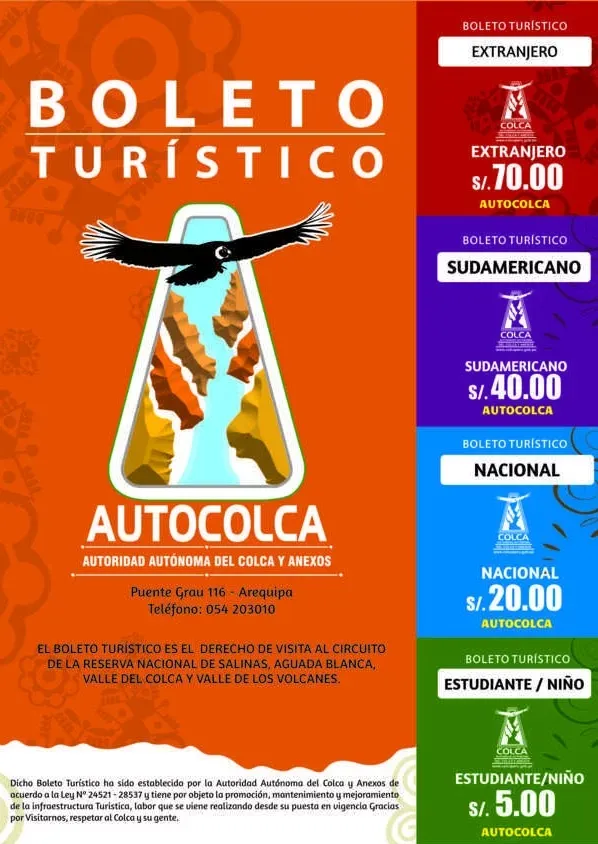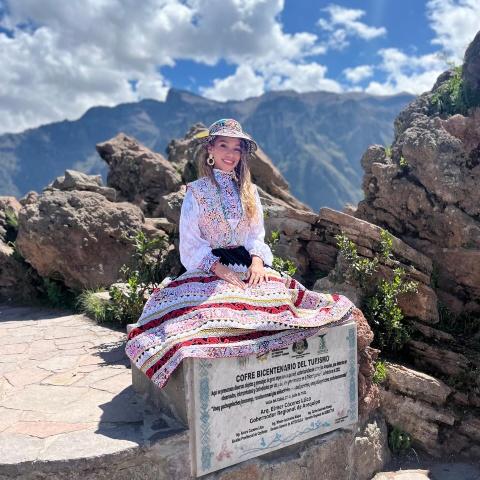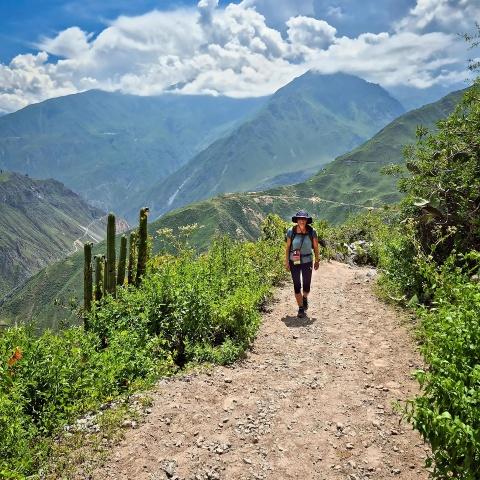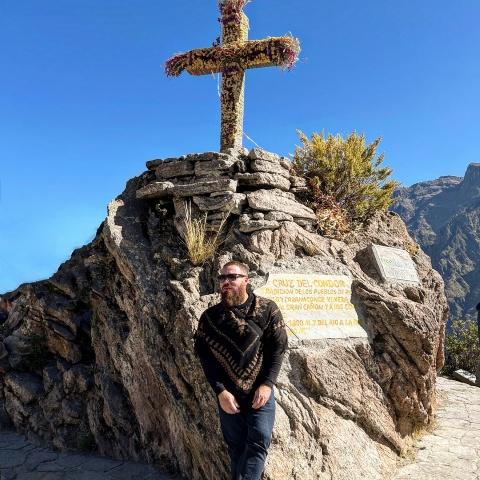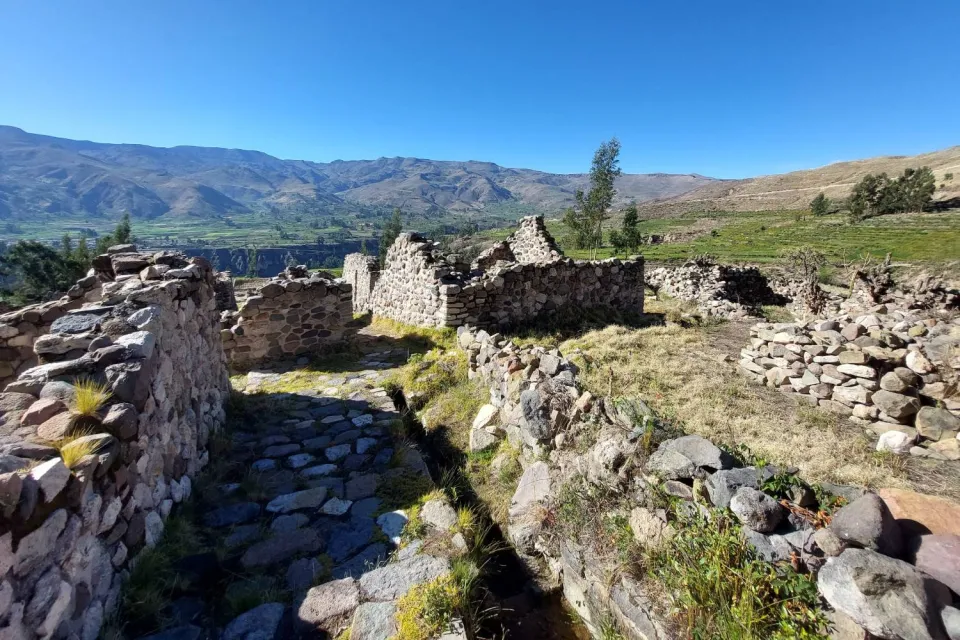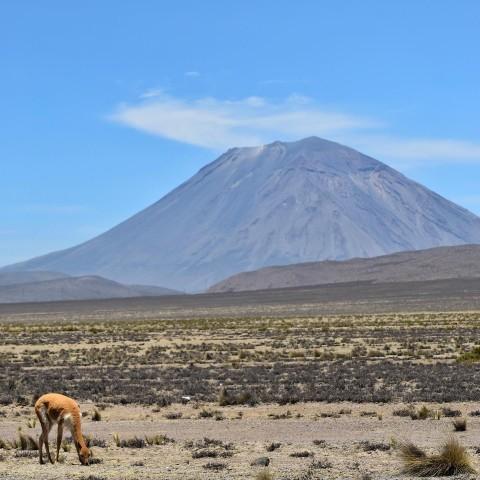The Colca Canyon is twice as deep as the Grand Canyon in the United States. This Andean abyss, with more than 3,000 meters of depth, is the stage for the majestic flight of the condor, the eternal watch of the volcanoes, and the life of towns that keep their ancestral traditions alive.
Here you don’t just come to look: you come to feel the immensity, to challenge the altitude, and to discover one of Peru’s best-kept natural secrets. Are you ready to step into one of the deepest and least-known canyons on the planet?
History of Colca Canyon
The Collagua and Cabana cultures were the first to inhabit the Colca Canyon. They devoted themselves to agriculture and lived on these lands for centuries. To adapt to the terrain, they built impressive terraces on the canyon slopes.
In the 15th century, the Incas conquered the area and integrated Colca into their empire. They built roads, bridges, and aqueducts that carried water from the Colca River to their cities, leaving behind traces of their advanced engineering.
With the arrival of the Spaniards in 1533, much of the Inca heritage was damaged: they destroyed buildings, introduced diseases, and imposed violence on the local population. For a long time, it remained forgotten by foreign visitors.
Today, the Canyon welcomes thousands of travelers each year, drawn by the majesty of its landscapes and the richness of its history
Geography
It is located in the heart of the Andes in Peru. With more than 3,000 meters of depth, it is one of the deepest canyons in the world, far surpassing the Grand Canyon in the United States.
Its territory combines imposing landscapes, great natural wealth, and indigenous communities that still preserve their traditions. The canyon was formed after millions of years of erosion of the Andean mountains, which gave rise to its dramatic and spectacular relief.
Flora and Fauna
It stands out for its extraordinary biodiversity. More than 100 bird species fly across its skies, among them the majestic Andean condor, symbol of the Andes.
On its slopes and valleys, llamas, alpacas, and vicuñas also live, animals that are part of the daily life of local communities. The vegetation is just as varied: from high andean plants to emblematic species such as native cacti, which withstand the area’s extreme climate.
Climate
It has a typical climate of southern Peru’s highlands: sunny, warm days, but cold nights. During the day, temperatures usually range between 15 °C and 23 °C, ideal for walking and exploring. At nightfall, the temperature drops sharply and can go down to 5 °C or less in the highest villages.
In the elevated areas, the wind increases the feeling of cold, while in the lower valleys, the climate is milder.
What is the best time to visit Colca Canyon?
The Canyon is a beautiful place to visit year round, but the best time to go is from May to September. This is because the weather is dry and sunny, and the temperatures are warm (but not too hot). From October to April, there may be heavy rain and cold in the canyon, making it not the best season for hiking or visiting the hot springs.
How to get to Colca Canyon from Arequipa
To reach Colca Canyon from Arequipa, the most practical way is to take a bus at the Arequipa Bus Terminal, located at Arturo Ibáñez Street 130. The trip to Chivay, the gateway to the valley, takes about 3 to 3.5 hours, crossing impressive high-Andean landscapes.
Once in Chivay, you will find private or shared transport options that take you to the main viewpoints of the canyon. The most famous is the Cruz del Cóndor Viewpoint, where you can observe the majestic flight of the Andean condor and enjoy a unique panoramic view of the valley.
Accommodation in Colca Canyon
Most options are concentrated in Chivay and Yanque, the valley’s main tourist centers. They offer accommodation for all tastes and budgets, from simple hostels and guesthouses to hotels with greater comfort and luxury services.
If you are looking for a budget trip, you will find hostels and guesthouses with basic rooms, shared bathrooms, and even shared dorms for backpackers. Prices usually start at USD 10 per night.
On the other hand, if you prefer more comfort, mid range and high end hotels offer private rooms with private bathrooms, pools, restaurants, and bars. These alternatives usually cost from USD 50 per night.
Tip: Book in advance during the high season (May to September), as demand grows due to the good weather and the large influx of visitors.
What to see inside Colca Canyon
Cruz del Cóndor Viewpoint
The Cruz del Cóndor Viewpoint is a must-stop on your visit to Colca. From here, you’ll enjoy a spectacular panoramic view of the canyon and, with a bit of luck, the majestic flight of the Andean condor, a sacred bird for the Incas.
Keep in mind that in September and October, during the nesting season, it is less likely to see condors in flight.
Andean communities of the Colca Valley
The Colca Valley brings together 14 Andean villages that preserve unique history, traditions, and landscapes. There you can explore colonial churches, admire Inca agricultural terraces, and participate in traditional festivities that keep the spirit of the Andes alive.
Some of the most notable villages are:
- Yanque: Located just 8 km from Chivay, it is a classic stop on Colca tours. Its main square and the Church of the Immaculate Conception reflect colonial heritage. You can also watch typical dances in the square and buy local handicrafts.
- Maca: Famous for the Church of Santa Ana, decorated with mirrors and gold leaf. Its small handicraft market is ideal for purchasing traditional products.
- Pinchollo: The Church of San Sebastián and its Plaza de Armas stand out in this village. From here, excursions depart to a natural geyser and the Hualca Hualca volcano. Very close is the Antahuilque Viewpoint, which offers one of the most impressive views of the canyon.
- Cabanaconde: One of the most important villages in the valley and the last on the route. From here begin the treks into the heart of the canyon, including the descent to the famous Oasis of Sangalle.
What to do in Colca Canyon
Hiking in the Canyon
Colca Canyon is a paradise for hiking lovers. Its multiple routes allow you to cross spectacular landscapes, from Inca terraces to natural viewpoints. Get ready with proper footwear, enough water, and sunscreen to make the most of the walk.
Relax in the hot springs
After a day of trekking, nothing is better than soaking in the valley’s hot springs. Several are located near the canyon and offer a revitalizing bath surrounded by mountains. Some are more accessible than others, so ask for directions before you go.
Kayaking on the Colca River
If you’re looking for adrenaline, try kayaking on the Colca River. Floating between gentle rapids and Andean landscapes makes this one of the most fun experiences in the valley. The activity is suitable for all ages, as long as you wear a life jacket and follow safety rules.
Explore the ruins
In the canyon’s surroundings, you will find archaeological ruins that reveal the history of ancient Andean civilizations. These sites showcase original architecture and allow you to connect with the valley’s ancestral memory. Don’t forget your camera: every corner is worth a photo.
Curiosities of Colca Canyon
- It is the fourth deepest canyon in the world and surpasses the famous Grand Canyon in Arizona, United States, in depth.
- It houses extraordinary biodiversity: more than 100 bird species, around 300 types of plants, and at least 30 varieties of cacti.
- Its highest point is Mount Ampato, at 6,388 m a.s.l.
- It is home to the majestic Andean condor, one of the largest flying birds on the planet, capable of reaching a 3 meter wingspan and weighing up to 12 kilos.
- The canyon takes its name from the Colca River, which runs through it from end to end.
- It is surrounded by imposing volcanoes such as Sabancaya and Ampato. In the latter, the famous mummy Juanita was found, one of the most important archaeological discoveries in Peru.
Tickets to Colca Canyon
To enter the Canyon, you need to purchase the Colca Valley Tourist Ticket, which includes access to several areas of the valley and its surroundings.
The rates vary depending on the type of visitor:
| Foreign tourist | S/ 70.00 |
| South American tourist | S/ 40.00 |
| Foreign or South American children (6 to 15 years old) | S/ 20.00 |
| National tourist | S/ 20.00 |
| University students, national children (6 to 15 years old) and seniors (+60 years old) | S/ 5.00 |
| Entrance to the Chacapi Hot Springs | S/ 15.00 |
Important: Children under 5 years old do not pay admission.
What places does the Colca Valley Tourist Ticket include?
With this ticket you can visit the following places:
- Colca Valley: Includes the villages located around the canyon, such as Tisco, Sibayo, Callalli, Tuti, Coporaque, Chivay, Yanque, Ichupampa, Achoma, Maca, Lari, Madrigal, Tapay, Cabanaconde, Huambo, Huanca, Lluta, San Antonio de Chuca, Caylloma, and Majes.
- Salinas and Aguada Blanca National Reserve: Located between the provinces of Arequipa and Caylloma, this reserve protects important high-Andean ecosystems and is home to species such as vicuñas and flamingos.
- Valley of the Volcanoes: Located in the districts of Andagua, Chachas, and Ayo, in the province of Castilla, Arequipa. This area is famous for its unique volcanic landscape.
Important: The tourist ticket does not include entry to:
- La Calera Hot Springs
- Uyo Uyo Archaeological Complex
Where to buy the Colca Tourist Ticket?
Currently, it cannot be purchased online, but you can buy it at the following places:
Arequipa – Autocolca Tourist Information Office
- Address: Portal de la Municipalidad N°112 (Plaza de Armas)
- Hours: Monday to Friday from 8:00 a.m. to 3:45 p.m.
Validity of the ticket: The Colca Valley Tourist Ticket is valid for 7 days from the time of purchase.
Altitude sickness and how to avoid it
Colca Canyon is located between 2,900 and 4,500 m a.s.l., so it is common for some travelers to suffer from altitude sickness.
Symptoms vary from person to person. In some cases, it appears as a mild headache or dizziness that disappears with acclimatization. In others, the effects are stronger and may require oxygen or medical attention.
To enjoy your trip without setbacks, take it easy and let your body adapt. Here are some practical tips:
- Take it easy the first few days: avoid running or doing intense efforts to give your body time.
- Stay hydrated: drinking enough water helps compensate for the lack of oxygen and speeds up adaptation.
- Use traditional Andean remedies: chew coca leaves or drink coca tea, a local custom that relieves symptoms.
- Consult your doctor: ask whether to bring altitude sickness pills or even a small oxygen tank.
- Preparing in advance and listening to your body will make the difference in your Colca experience.
Tips for travelers
To make the most of your visit, keep these practical recommendations in mind:
- Plan ahead: book accommodation and tours in advance to get better prices and ensure availability.
- Prepare physically: some hikes are demanding; stay in good physical condition to enjoy them.
- Pack a light, useful backpack: bring essentials such as medicine, painkillers, flashlight, toilet paper, and a power bank.
- Protect your skin: the sun at high altitude is intense; use sunscreen, a hat, and sunglasses.
- Dress warmly: although Arequipa is warm, in Colca temperatures drop a lot at night and at dawn.
- Bring your ID: you will need your passport or official document to buy the entry ticket.
- Carry local cash: many places don’t accept cards, so bring Peruvian soles to pay for snacks, drinks, or souvenirs.
- Use insect repellent: in high season, mosquitoes can be annoying.
- Prepare for hot springs: pack sandals and a swimsuit if you want to relax in the thermal baths.
- Get travel insurance: having medical and accident coverage will give you peace of mind during your visit.
Safety in Colca Canyon
When traveling to Colca Canyon, it is important to know the risks and take basic precautions. In the area, animals such as snakes and spiders live, and even wild dog attacks have been reported.
To stay safe during hikes:
- Stay on marked trails and avoid wandering off alone.
- Wear appropriate shoes and clothing, and always carry enough water.
If you decide to camp, choose a safe place away from cliffs or rivers. Secure your tent well and never leave food or trash outdoors, as it can attract animals.
With simple precautions, your experience will be safe and much more enjoyable.
Final recommendations
Colca Canyon is one of Peru’s most impressive natural wonders and should be at the top of your travel list this place offers experiences you will remember forever.
To make the most of your visit:
- Take enough time: don’t underestimate the canyon’s size. Dedicate at least two days to explore and enjoy its views.
- Do a hike: there are routes for all levels. Even if you’re not an experienced hiker, a short walk will let you feel Colca’s greatness.
- Observe its wildlife: keep your eyes on the sky and trails. You may spot the Andean condor, as well as llamas, alpacas, vicuñas, eagles, and more species that inhabit this unique environment.
Exploring Colca is living a perfect mix of nature, culture, and adventure.
Nearby places to visit around the Canyon
Uyo Uyo Archaeological Complex
Just 2.5 km from Yanque you will find one of the most important settlements of the Collagua culture. The archaeological complex rises more than 3,500 m a.s.l. and preserves urban, agricultural, and ceremonial sectors. Among its remains stand out water channels and an astronomical clock, a testimony of the advanced engineering of its ancient inhabitants.
Salinas and Aguada Blanca National Reserve
With more than 360,000 hectares, this reserve protects unique high-Andean ecosystems. Here you can observe vicuñas, flamingos, and deer in their natural habitat. In addition, the place offers spectacular views of the Misti, Chachani, and Ubinas volcanoes.
Volcanoes Viewpoint
Located at 4,800 m a.s.l., it is the highest point between Arequipa and Colca. From here you will see the imposing Ampato, Sabancaya, and Hualca Hualca volcanoes, in one of the most memorable landscapes of the entire route.
Mucurca Lagoon
Very close to Cabanaconde lies this lagoon at 4,350 m a.s.l. Its shores offer a direct view of the Sabancaya volcano and a natural environment that transmits peace and absolute silence.
La Calera Hot Springs
Just 3 km from Chivay, these hot springs are perfect for relaxing after a day of hiking. Their minerals, such as calcium and zinc, relieve muscle aches while you enjoy the valley’s fresh air.
Chimpa Fortress
In the district of Madrigal rises this ancient stone construction built by the Collaguas. From the top of the fortress, you will have a panoramic view of the Canyon and traditional villages such as Cabanaconde and Tapay.
Frequently Asked Questions
- What is the best time to see condors in Colca Canyon?
The best time to see condors flying in Colca Canyon is between 7:00 a.m. and 8:00 a.m., when air currents make it easier for them to rise and glide over the valley.
- How much time is recommended to visit Colca Canyon?
Ideally, dedicate at least two full days: one to explore the viewpoints and villages, and another for hiking or activities.
- Are there ATMs in Colca Valley?
Yes, but they are concentrated in Chivay and are not always stocked. It is recommended to carry cash in Peruvian soles.
- Is Colca Canyon suitable for children or seniors?
Yes, as long as the most demanding hikes are avoided. Gentle activities, such as visiting viewpoints or hot springs, can be enjoyed without much physical effort.
- Is a guide needed to trek in Colca?
It is not mandatory, but it is recommended, especially for long treks or if you don’t know the area well. A local guide enhances the experience, provides safety, and adds historical and cultural context.
- Where can you watch the sunrise in Colca Canyon?
One of the best places is the Cruz del Cóndor Viewpoint. Arriving before 7:00 a.m. will let you see the sun illuminate the canyon and possibly spot condors flying.
- Is there internet and phone signal in the Canyon?
In the main villages, yes, but inside the canyon coverage is limited. Many lodgings offer basic wifi.
- Is it possible to visit the Canyon in just one day from Arequipa?
Yes, there are 1-day tours that leave very early and return at night, although the experience may feel rushed.
- Can you visit the Canyon year-round?
Yes, but the experience varies. Between May and September the weather is dry and sunny, ideal for hiking. Between December and March, rains are frequent, making trails more slippery.
- What is the difference between Colca Valley and Colca Canyon?
Colca Valley includes villages, agricultural terraces, and the upper course of the Colca River. Colca Canyon corresponds to the deepest, steepest part, where the most famous viewpoints and treks are located.
Colca Canyon is not just a destination it is an experience that blends history, nature, and living culture in the heart of the Peruvian Andes. Its deep landscapes, the flight of the Andean condor, and the warmth of its communities make this place an unforgettable trip. Whether you’re looking for adventure on its trekking routes, relaxation in its hot springs, or connection with ancestral traditions, Colca has something unique for every traveler.
Ready to discover one of the deepest canyons on the planet?
At Ultimate Trekking, we can customize your tour to Colca Canyon, adapting it to your time, interests, and travel style.
Contact us today and start planning your adventure in this natural treasure of Peru.

